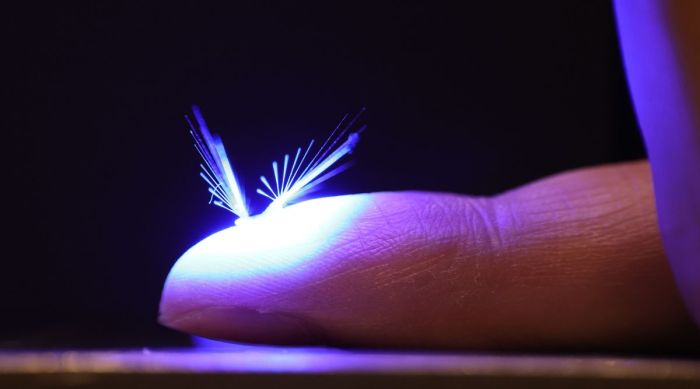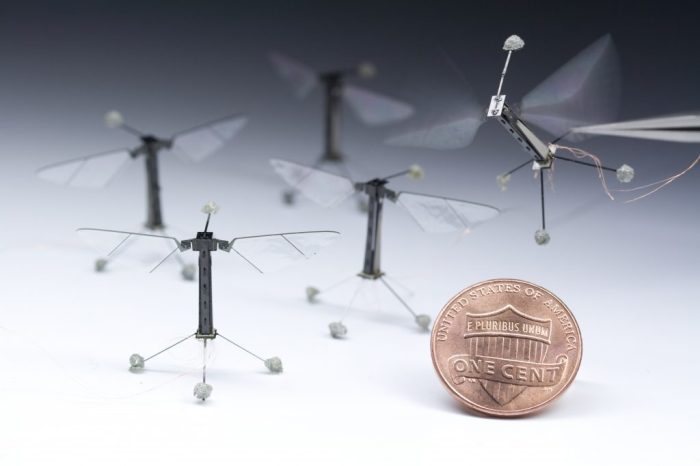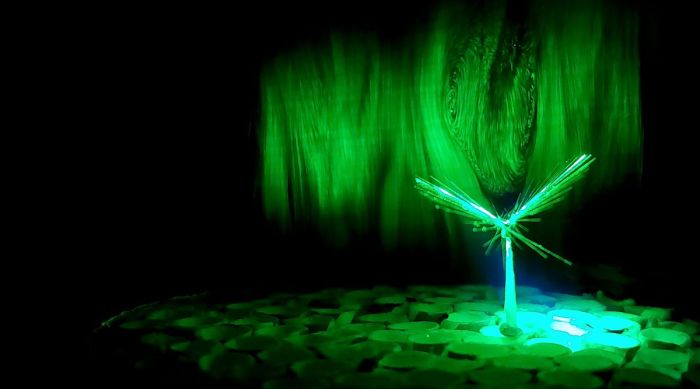Tiny flying robot could work as artificial pollinator – Tiny flying robots could work as artificial pollinators, a concept that sounds like something out of a science fiction movie, but it’s becoming a real possibility. With natural pollinator populations declining at alarming rates, scientists are exploring alternative solutions to ensure the continued health of our ecosystems and food supply.
These tiny robots, designed to mimic the pollination process of bees and other insects, could potentially fill the gap and safeguard our planet’s biodiversity.
Imagine a world where tiny, autonomous drones flit from flower to flower, collecting pollen and transferring it to other blooms, effectively replicating the vital work of bees. This is the vision that researchers are working towards, and the potential benefits are vast.
Artificial pollinators could not only help to maintain crop yields but also contribute to the preservation of endangered plant species and even play a role in restoring degraded ecosystems.
The Need for Artificial Pollinators
The natural world is facing a silent crisis – a decline in pollinator populations, including bees, butterflies, and other insects. This decline has far-reaching consequences for our ecosystems and food security. Pollinators play a vital role in the reproduction of plants, contributing to the diversity and abundance of life on Earth.
The Impact of Pollinator Decline
Pollinator decline poses a significant threat to biodiversity and the stability of ecosystems. Without pollinators, many plants would struggle to reproduce, leading to a decline in plant populations and the loss of vital habitats for other species. This interconnectedness underscores the importance of pollinators in maintaining a healthy and balanced ecosystem.
- Food Production:Pollinators are essential for the production of many fruits, vegetables, nuts, and seeds that form the basis of our food supply. A decline in pollinators could lead to food shortages and price increases, impacting global food security.
- Biodiversity:Pollinators support the diversity of plant life, which in turn provides habitat and resources for countless other species. Their decline can disrupt intricate ecological relationships and threaten the overall health of ecosystems.
Benefits of Artificial Pollinators
Artificial pollinators offer a potential solution to address the pollination challenges posed by declining pollinator populations. These innovative technologies can help ensure food security and preserve biodiversity.
Find out about how a chief automation officer could transform your business heres how can deliver the best answers for your issues.
- Sustainable Pollination:Artificial pollinators can provide a reliable and consistent source of pollination, mitigating the risks associated with natural pollinator decline and ensuring a stable food supply.
- Targeted Pollination:Artificial pollinators can be programmed to target specific crops, maximizing pollination efficiency and optimizing crop yields. This targeted approach can also help to reduce the spread of diseases and pests.
- Environmental Benefits:Artificial pollinators can reduce the need for pesticides and herbicides, promoting sustainable agricultural practices and minimizing the impact on natural ecosystems.
Tiny Flying Robots

The concept of tiny flying robots, or microbots, as artificial pollinators is a fascinating prospect, requiring careful design and engineering to ensure their effectiveness and safety. These robots need to be lightweight, maneuverable, and equipped with the necessary tools for pollen collection and delivery.
Design and Functionality
The design of a tiny flying robot for pollination must prioritize efficiency and effectiveness. The robot needs to be small enough to navigate the intricate structures of flowers while being robust enough to withstand the rigors of flight and landing.
- Size and Weight:These robots need to be extremely small, ideally with a wingspan of a few centimeters and a weight of less than a gram. This will allow them to access delicate flowers without damaging them.
- Material:Lightweight and durable materials such as carbon fiber, polymers, or even bio-compatible materials could be used for the robot’s body and wings.
- Power Source:Micro-batteries or energy harvesting systems like solar cells could provide power for the robot’s flight and operations.
Flight Control and Navigation
Flight control and navigation are crucial for these robots to effectively reach flowers and collect pollen.
- Flight Control:Miniature wings or propellers powered by micro-motors will allow the robot to take off, land, and maneuver within the environment. Advanced control algorithms and sensors will be needed to stabilize the robot’s flight and ensure precise movements.
- Navigation:GPS or visual navigation systems could be used to guide the robots to specific areas where pollinating plants are located. Visual sensors could also be used for identifying specific flowers and navigating through complex environments.
- Target Identification:Cameras or other sensors could be used to identify specific flowers based on their color, shape, and scent. This information could be used to guide the robot to the right flower and ensure the transfer of pollen to the correct stigma.
Pollen Collection and Delivery
The most important aspect of the robot’s design is its ability to collect and deliver pollen efficiently.
- Pollen Collection:Electrostatic forces or brushes could be used to collect pollen from the anthers of flowers. The collected pollen could be stored in a small container or attached to the robot’s body.
- Pollen Delivery:The robot could then fly to a different flower and use a similar mechanism to deposit the pollen onto the stigma, facilitating pollination.
Technological Challenges and Solutions: Tiny Flying Robot Could Work As Artificial Pollinator
Creating tiny flying robots capable of pollinating plants presents numerous technological hurdles. These robots must be incredibly small, consume minimal energy, and maintain stability during flight. Researchers are actively exploring solutions to these challenges, drawing inspiration from nature and pushing the boundaries of engineering.
Miniaturization
Miniaturization is a key challenge, as the robots need to be small enough to navigate delicate flowers without causing damage. This requires innovative design and fabrication techniques.
- Micro-Electro-Mechanical Systems (MEMS):MEMS technology allows for the creation of miniature sensors, actuators, and other components. This enables the development of tiny robots with intricate features and functionalities.
- 3D Printing:3D printing, particularly with materials like polymers and composites, facilitates the production of complex and lightweight robot structures. This method enables rapid prototyping and customization for specific pollination tasks.
- Bio-inspired Design:Researchers are studying the flight mechanisms of insects like bees and hummingbirds to glean insights into efficient and agile flight. This approach can inform the design of wings, propellers, and control systems.
Power Consumption
The tiny robots must operate for extended periods on limited power sources. This necessitates efficient energy storage and management.
- Lightweight Batteries:Researchers are developing high-capacity, lightweight batteries using materials like lithium-ion and lithium-sulfur. These batteries offer greater energy density and longer operating times.
- Energy Harvesting:Energy harvesting technologies, such as solar panels and piezoelectric materials, can supplement battery power. These technologies can capture ambient energy sources like sunlight and vibrations, extending the robot’s operational range.
- Efficient Propulsion Systems:Optimization of propellers, wings, and other propulsion systems can minimize energy consumption during flight. Aerodynamic design and control algorithms play a crucial role in this area.
Stability and Control
Maintaining stability and control during flight is essential for precise pollination. Tiny robots are susceptible to wind gusts and air turbulence, requiring sophisticated control algorithms.
- Micro-Sensors:Micro-sensors like accelerometers, gyroscopes, and pressure sensors provide real-time feedback on the robot’s position and orientation. This data is used by control algorithms to adjust flight parameters.
- Advanced Control Algorithms:Control algorithms based on artificial intelligence and machine learning can enable autonomous flight and navigation, even in complex environments. These algorithms can learn from experience and adapt to changing conditions.
- Robust Structures:The robot’s structure must be robust enough to withstand the forces encountered during flight. Lightweight materials like carbon fiber and composites provide the necessary strength and resilience.
Examples of Research and Development
Several research institutions and companies are actively working on micro-robotics and autonomous flight for pollination.
- Harvard University:Researchers at Harvard have developed a robotic bee called RoboBee, which is about the size of a real bee. RoboBee uses MEMS technology and bio-inspired design to achieve flight.
- University of Tokyo:The University of Tokyo has created a small, flapping-wing robot called the “Micro-Aerial Vehicle.” This robot uses a lightweight, flexible structure and a unique flapping mechanism to achieve efficient flight.
- E-Motion Robotics:E-Motion Robotics is a company that develops micro-robots for pollination and other applications. Their robots are designed to be lightweight, efficient, and adaptable to various environments.
Environmental Impact and Ethical Considerations

The development of artificial pollinators, while promising a solution to declining pollinator populations, also raises significant concerns regarding their potential impact on the environment and the ethical implications of replacing natural pollinators with machines.
Potential Environmental Impact
The environmental impact of deploying artificial pollinators is a complex issue with both potential benefits and risks.
- Reduced reliance on pesticides and herbicides: Artificial pollinators can potentially reduce the need for pesticides and herbicides used to control pests and weeds in agricultural settings. This could benefit biodiversity and ecosystem health by minimizing the negative impacts of these chemicals on non-target organisms.
- Potential for habitat restoration: Artificial pollinators could play a role in restoring degraded habitats by facilitating pollination of native plants. This could contribute to the recovery of endangered species and increase biodiversity in specific areas.
- Risk of unintended consequences: The introduction of artificial pollinators into natural ecosystems could have unforeseen consequences. For instance, they might outcompete natural pollinators, leading to a decline in their populations.
- Impact on pollination networks: Artificial pollinators may not be as effective as natural pollinators in supporting complex pollination networks. Natural pollinators often exhibit specialized relationships with specific plants, contributing to genetic diversity and ecosystem stability.
Ethical Implications, Tiny flying robot could work as artificial pollinator
The ethical implications of replacing natural pollinators with robots are multifaceted and raise important questions about our relationship with nature.
- Moral responsibility for natural pollinators: There are ethical concerns about replacing natural pollinators with machines, especially considering the vital role they play in maintaining biodiversity and ecosystem health. We have a moral responsibility to protect and conserve natural pollinators, and the widespread deployment of artificial pollinators could undermine these efforts.
- Impact on human-nature relationships: Replacing natural pollinators with machines could further distance humans from nature and erode our appreciation for the interconnectedness of living organisms. This could have profound implications for our understanding and respect for the natural world.
- Potential for unintended consequences: Replacing natural pollinators with artificial ones could have unintended consequences, such as the disruption of natural ecosystems or the creation of new environmental problems. It is crucial to consider the long-term implications of this technological intervention and ensure that it does not create more problems than it solves.
Future Prospects and Applications

The development of tiny flying robots as artificial pollinators is a testament to human ingenuity and the potential to address critical environmental challenges. However, the scope of their application extends far beyond simply replicating the pollination process. These miniature marvels hold the promise of revolutionizing various fields, impacting agriculture, environmental monitoring, and even healthcare.
Expanding Applications Beyond Pollination
The versatility of tiny flying robots makes them suitable for a wide range of tasks beyond pollination. Their small size and maneuverability allow them to access confined spaces and perform intricate operations.
- Precision Agriculture:These robots can be equipped with sensors to monitor crop health, identify pests and diseases, and deliver targeted treatments. This precision approach can optimize resource utilization and minimize environmental impact.
- Environmental Monitoring:Tiny flying robots can be deployed to monitor air quality, track wildlife populations, and assess the impact of climate change. Their ability to access remote and hazardous areas makes them invaluable for environmental research and conservation efforts.
- Search and Rescue:In disaster situations, these robots can navigate treacherous terrain and locate survivors, providing vital information to rescue teams.
- Infrastructure Inspection:Tiny flying robots can inspect bridges, power lines, and other critical infrastructure for damage, reducing the need for hazardous and time-consuming manual inspections.
Integrating Artificial Intelligence and Machine Learning
Artificial intelligence (AI) and machine learning (ML) play a crucial role in optimizing the performance of artificial pollinators. By integrating these technologies, we can:
- Improve Navigation and Targeting:AI algorithms can enable robots to navigate complex environments and accurately target flowers for pollination. This ensures efficient and effective pollination, maximizing yield and minimizing waste.
- Optimize Pollination Strategies:ML models can analyze data on pollen types, flower characteristics, and environmental conditions to determine the most effective pollination strategies for different crops. This personalized approach can significantly enhance pollination efficiency.
- Adapt to Changing Environments:AI-powered robots can learn and adapt to changing environmental conditions, such as variations in temperature, humidity, and wind patterns. This adaptability ensures their effectiveness in diverse and unpredictable environments.
Shaping the Future of Agriculture and Environmental Sustainability
Artificial pollinators have the potential to transform agriculture and contribute to a more sustainable future. They can help address the challenges of declining pollinator populations, climate change, and food security.
- Enhanced Crop Yields:By ensuring efficient and reliable pollination, artificial pollinators can significantly increase crop yields, contributing to global food security. This can alleviate pressure on existing agricultural land and reduce the need for expansion into sensitive ecosystems.
- Sustainable Farming Practices:These robots can facilitate the adoption of sustainable farming practices by minimizing pesticide use and reducing the need for manual labor. This can have a positive impact on biodiversity and soil health.
- Climate Change Resilience:Artificial pollinators can help crops adapt to the challenges of climate change by ensuring consistent pollination even under extreme weather conditions. This can enhance the resilience of agricultural systems to climate variability.





